Thiomargarita
A Microbial Biorealm page on the genus Thiomargarita

Classification
Higher order taxa:
Bacteria, Proteobacteria, Gammaproteobacteria, Thiotrichales, Thiotrichaceae
Species:
Thiomargarita namibienus
|
NCBI: Taxonomy Genome |
Description and Significance
Discovered in 1999 off the coast of Namibia, Thiomargarita namibiensis has the distinction of being the largest bacterium in the world, at a remarkable volume of 3 million times that of a normal bacterial specimen. The long string of cells, named "Sulfur pearl of Namibia" because of the reflective white globules of sulfur contained in them, was found buried in the sulfur-abundant sea floor. Each ball-shaped cell can grow up to nearly 1 milimeter in diameter--a measurement usually taken in microns. Because of some unique adaptations, Thiomargarita namibiensis is able to survive in a high-sulfur environment with little or no oxygen.
Genome Structure
By studying Thiomargarita namibiensis' genes, scientists were able to pinpoint the bacterium's placement in the phylogenetic tree, as close relations to the bacterial genera Triploca and Beggiatoa, which have to contend with similar environmental challenges.
Cell Structure and Metabolism
Thiomargarita namibiensis' environment poses the necessity for a unique adaptation: they have to be able to oxidize nitrate into sulfide in the low-nitrate conditions of their oxygen-poor habitat. This bacterium has accomplished this by having the ability to store both sulfur and nitrate. Each individual bacterial cell is almost entirely made up of a liquid vacuole, in which is contained large amounts of nitrate, often 10,000 times the amount in the surrounding seawater. The bacteria use this store of nitrate, gathered when it is abundant in the water surrounding the cells, to oxidize the sulfur from the seafloor. The cytoplasm of the cells line the inside of the cell membrane, allowing the bacterium the flexibility to diffuse the nitrate with the outside sulfide and giving it its huge size. Unlike its relation Triploca, Thiomargarita namibiensis does not have to migrate vertically in order to collect enough nitrate to properly oxidize; its cells can live submerged in the sediment for up to three months before requiring nitrate from the outside environment. They have also developed capabilities to withstand extreme environmental changes, such as an influx of oxygen or sulfide.

Ecology
Thiomargarita namibiensis is found in the sulfur-rich sediments of the ocean floor, where they play an important ecological role. By oxidizing sulfur they act as detoxifiers, removing the poisonous gas from the water and keeping it hospitable for the fish and other marine organisms. Locations such as the one where Thiomargarita namibiensis was first uncovered are rich in phytoplankton. When this phytoplankton sinks to the bottom, the organic material is oxidized by anaerobic bacteria on the seafloor. The oxidation yields a large amount of sulfide, which Thiomargarita namibiensis is able to oxidize through a number of morphological adaptations. Like the coast of Namibia, the west coast of South America is also abundant with phytoplankton, providing an ideal habitat for Thiomargarita namibiensis. [[Image:Tnamibiensis.jpg|thumb|300px|right| Photo comparing a cell of Thiomargarita namibiensis to the eye and head of a fruit fly. The bacterium's size in proportion to other bacteria is described by scientists to be that of a blue whale to a newborn mouse.
References
Henahan, Sean. Giant Bacteria Discovered. Access Excellence, The National Health Museum. 1999.
Monsters Among the Microbes. Microbe.org, American Society for Microbiology.
The World's Largest Bacteria. Wood's Hole Oceanographic Institution. 1999.
